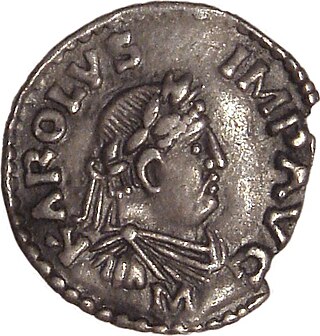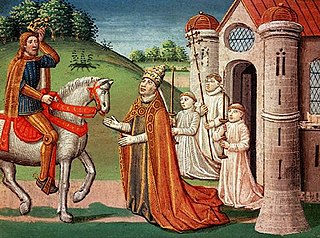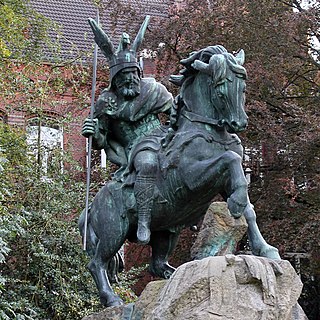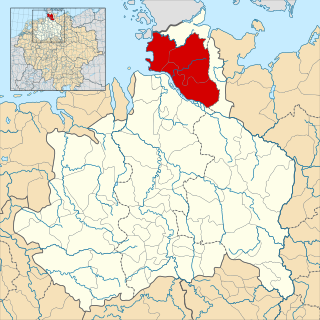
Charlemagne was King of the Franks from 768, King of the Lombards from 774, and Emperor of the Carolingian Empire from 800, all until his death in 814. Charlemagne succeeded in uniting the majority of Western Central Europe, and he was the first recognized emperor to rule in the west after the fall of the Western Roman Empire approximately three centuries earlier. Charlemagne's rule saw a program of political and societal changes that had a lasting impact on Europe in the Middle Ages.

The Saxons were a group of Germanic peoples whose name was given in the early Middle Ages to a large country near the North Sea coast of northern Germania, in what is now Germany. In the late Roman Empire, the name was used to refer to Germanic coastal raiders, and in a similar sense to the later "Viking". Their origins are believed to be in or near the German North Sea coast where they appear later, in Carolingian times. In Merovingian times, continental Saxons had been associated with the activity and settlements on the coast of what later became Normandy. Their precise origins are uncertain, and they are sometimes described as fighting inland, coming into conflict with the Franks and Thuringians. There is possibly a single classical reference to a smaller homeland of an early Saxon tribe, but its interpretation is disputed. According to this proposal, the Saxons' earliest area of settlement is believed to have been Northern Albingia. This general area is close to the probable homeland of the Angles.
The 780s decade ran from January 1, 780, to December 31, 789.
The 770s decade ran from January 1, 770, to December 31, 779.

Year 772 (DCCLXXII) was a leap year starting on Wednesday of the Julian calendar. The denomination 772 for this year has been used since the early medieval period, when the Anno Domini calendar era became the prevalent method in Europe for naming years.

Year 782 (DCCLXXXII) was a common year starting on Tuesday of the Julian calendar, the 782nd year of the Common Era (CE) and Anno Domini (AD) designations, the 782nd year of the 1st millennium, the 82nd year of the 8th century, and the 3rd year of the 780s decade. The denomination 782 for this year has been used since the early medieval period, when the Anno Domini calendar era became the prevalent method in Europe for naming years.

Year 784 (DCCLXXXIV) was a leap year starting on Thursday of the Julian calendar, the 784th year of the Common Era (CE) and Anno Domini (AD) designations, the 784th year of the 1st millennium, the 84th year of the 8th century, and the 5th year of the 780s decade. The denomination 784 for this year has been used since the early medieval period, when the Anno Domini calendar era became the prevalent method in Europe for naming years.

Widukind, also known as Wittekind and Wittikund, was a leader of the Saxons and the chief opponent of the Frankish king Charlemagne during the Saxon Wars from 777 to 785. Charlemagne ultimately prevailed, organized Saxony as a Frankish province, massacred thousands of Saxon nobles, and ordered conversions of the pagan Saxons to Christianity. In later times, Widukind became a symbol of Saxon independence and a figure of legend. He is also venerated as a blessed in the Catholic Church.

The Duchy of Saxony was originally the area settled by the Saxons in the late Early Middle Ages, when they were subdued by Charlemagne during the Saxon Wars from 772 and incorporated into the Carolingian Empire (Francia) by 804. Upon the 843 Treaty of Verdun, Saxony was one of the five German stem duchies of East Francia; Duke Henry the Fowler was elected German king in 919.
The Massacre of Verden was an event during the Saxon Wars where the Frankish king Charlemagne ordered the death of 4,500 Saxons in October 782. Charlemagne claimed suzerainty over Saxony and in 772 destroyed the Irminsul, an important object in Saxon paganism, during his intermittent thirty-year campaign to Christianize the Saxons. The massacre occurred in Verden in what is now Lower Saxony, Germany. The event is attested in contemporary Frankish sources, including the Royal Frankish Annals.

An Irminsul was a sacred, pillar-like object attested as playing an important role in the Germanic paganism of the Saxons. Medieval sources describe how an Irminsul was destroyed by Charlemagne during the Saxon Wars. A church was erected on its place in 783 and blessed by Pope Leo III. Sacred trees and sacred groves were widely venerated by the Germanic peoples, and the oldest chronicle describing an Irminsul refers to it as a tree trunk erected in the open air.

Donar's Oak was a sacred tree of the Germanic pagans located in an unclear location around what is now the region of Hesse, Germany. According to the 8th century Vita Bonifatii auctore Willibaldo, the Anglo-Saxon missionary Saint Boniface and his retinue cut down the tree earlier in the same century. Wood from the oak was then reportedly used to build a church at the site dedicated to Saint Peter. Sacred trees and sacred groves were widely venerated by the Germanic peoples.

The Marsi were a small Germanic tribe settled between the Rhine, Ruhr and Lippe rivers in northwest Germany. It has been suggested that they were a part of the Sugambri who managed to stay east of the Rhine after most Sugambri had been moved from this area. Strabo describes the Marsi as an example of a Germanic tribe who were originally from the Rhine area, now the war-torn Roman frontier, but had migrated deep into Germania.

Old Saxony was the homeland of the Saxons during the Early Middle Ages. It corresponds roughly to the modern German states of Lower Saxony, eastern part of modern North Rhine-Westphalia state (Westphalia), Nordalbingia and western Saxony-Anhalt (Eastphalia), which all lie in northwestern Germany. It had four provinces: Nordalbingia, Eastphalia, Westphalia and Angria, these provinces, in turn, were divided into smaller territories, the gaue, which are equivalent to modern Districts of Germany (Kreise), and were equivalent to the English shires.

The Saxon Wars were the campaigns and insurrections of the thirty-three years from 772, when Charlemagne first entered Saxony with the intent to conquer, to 804, when the last rebellion of tribesmen was defeated. In all, 18 campaigns were fought, primarily in what is now northern Germany. They resulted in the incorporation of Saxony into the Frankish realm and their forcible conversion from Germanic paganism to Christianity.

Obermarsberg is one of seventeen quarters in the municipality of Marsberg, North Rhine-Westphalia, Germany. It is situated on the site of an Old Saxon hillfort and refuge castle, the Eresburg, on a hill 130m above the Diemel river, a tributary of the River Weser.

Nordalbingia was one of the four administrative regions of the medieval Duchy of Saxony, the others being Angria, Eastphalia, and Westphalia. The region's name is based on the Latin name Alba for the Elbe River and refers to an area predominantly located north of the Lower Elbe, roughly corresponding with the present-day Holstein region. Situated in what is now Northern Germany, this is the earliest known dominion of the Saxons.

Christianity in the 8th century was much affected by the rise of Islam in the Middle East. By the late 8th century, the Muslim empire had conquered all of Persia and parts of the Eastern Roman (Byzantine) territory including Egypt, Palestine, and Syria. Suddenly parts of the Christian world were under Muslim rule. Over the coming centuries the Muslim nations became some of the most powerful in the Mediterranean basin.
Theodoric I was the Bishop of Paderborn from 908 to 916.

The Desenberg near Daseburg in the North Rhine-Westphalian county of Höxter is 343.6 m above sea level (NHN) and the most prominent hill in the Warburg Börde, a relatively level, fertile Börde region. The hill is a basalt knoll crowned by the ruins of Desenberg Castle and a relict of recent geological history and volcanism, as well as medieval feudalism and warfare. The present shape of the Desenberg has arisen through weathering.


















